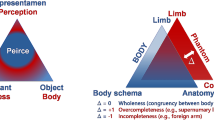Abstract
This paper brings neuroscientific experiments into relation with concepts from phenomenological philosophy to investigate phantom sensations from the perspective of embodied subjectivity. Using a mirror device to create intersensory effects in subjects experiencing phantom sensations, one can create illusions aiming at alleviating phantom pain. Neuroplasticity as a general property of the brain and cortical remapping as a specific mechanism underlying the success of this procedure are interpreted with the phenomenological notions of body image, body schema, and body memory. It is argued that a phantom can be understood as an ambiguous unity of body-imagistic neglect and body-schematic remembering. This neurophenomenological approach highlights the significance of the polarity of subjective-objective embodied experience one the one hand, and the spatial and temporal horizons of the emergence of phantoms on the other. Thereby, implicit and explicit forms of remembering, habitual and reflective modes of behavioural and cognitive self-representation and -understanding can be compared according to how the body integrates its various sensations.
Similar content being viewed by others
References
Sherman, R.A., and C.J. Sherman. 1983. Prevalence and characteristics of chronic phantom limb pain among American veterans. Results of a trial survey. American Journal of Physical Medicine 62 (5): 227–238.
Woodhouse, A. 2005. Phantom limb sensation. Clinical and Experimental Pharmacology and Physiology 32: 132–134.
Nikolajsen, L., and T.S. Jensen. 2001. Phantom limb pain. British Journal of Anaesthesia 87 (1): 107–116.
Melzack, R. 1989. Phantom limbs, the self and the brain. Canadian Psychology 30 (1): 1–16.
Merzenich, M.M., and J.H. Kaas. 1982. Reorganization of mammalian somatosensory cortex following peripheral nerve injury. Trends in Neurosciences 5: 434–436.
Ramachandran, V.S., and S. Blakeslee. 1998. Phantoms in the brain: Probing the mysteries of the human mind. New York: Morrow.
Schott, G.D. 1993. Penfield’s homunculus: A note on cerebral cartography. Journal of Neurology, Neurosurgery & Psychiatry 56 (4): 329–333.
Flor, H., T. Elbert, S. Knecht, C. Wienbruch, C. Pantev, and N. Birbaumer. 1995. Phantom-limb pain as a perceptual correlate of cortical reorganization following arm amputation. Nature 375: 482–484.
Andoh, J., M. Diers, C. Milde, C. Frobel, D. Kleinböhl, and H. Flor. 2017. Neural correlates of evoked phantom limb sensations. Biological Psychology 126: 89–97.
Plessner, H. (1980 [1928]). Die Stufen des Organischen und der Mensch. Frankfurt: Suhrkamp.
Merleau-Ponty, M. 1964. The philosopher and his shadow. In Signs, ed. R.C. McCleary, 159–181. Evanston: Northwestern University Press.
Wehrle, M. 2013. Medium und Grenze: Der Leib als Kategorie der Intersubjektivität. Phänomenologie und Anthropologie im Dialog. In Grenzen der Empathie. Philosophische, psychologische und anthropologische Perspektiven, ed. T. Breyer, 217–238. Paderborn: Wilhelm Fink.
Plügge, H. 1967. Der Mensch und sein Leib. Tübingen: Niemeyer.
Plügge, H. 1970. Vom Spielraum des Leibes. Klinisch-phänomenologische Erwägungen über “Körperschema” und “Phantomglied”. Salzburg: Müller.
Ramachandran, V.S. 1993. Behavioral and magnetoencephalograhic correlates of plasticity in the adult human brain. PNAS 90: 10413–10420.
Flor, H., T. Elbert, W. Mühlnickel, C. Pantev, C. Wienbruch, and E. Taub. 1998. Cortical reorganization and phantom phenomena in congenital and traumatic upper-extremity amputees. Experimental Brain Research 119 (2): 205–212.
Rinofner-Kreidl, S. 2009. Scham und Schuld. Zur Phänomenologie selbstbezüglicher Gefühle. Phänomenologische Forschungen 2009: 137–173.
Merleau-Ponty, M. (2012). Phenomenology of perception (Tr. D.A. Landes). London/New York: Routledge.
Gallagher, S. 2005. How the body shapes the mind. Oxford: Oxford University Press.
Bromage, P.R., and R. Melzack. 1974. Phantom limbs and body schema. Canadian Anaesthetists Society Journal 21: 267–274.
Weiss, S.A. 1958. The body image as related to phantom sensation: A hypothetical conceptualization of seemingly isolated findings. Annals of the New York Academy of Sciences 74: 25–29.
Auersperg, P.A. 1960. Körperbild und Körperschema. Nervenarzt 31: 76–96.
Joraschky, P., T. Loew, and F. Röhricht, eds. 2009. Körpererleben und Körperbild. Stuttgart: Schattauer.
Schmitz, H. (1965). Der Leib (= System der Philosophie, Vol. II/1). Bonn: Bouvier.
Fuchs, T. 2000. Leib, Raum, Person. Entwurf einer phänomenologischen Anthropologie. Stuttgart: Klett-Cotta.
Jensen, T.S., B. Krebs, J. Nielsen, and P. Rasmussen. 1985. Immediate and long-term phantom limb pain in amputees: Incidence, clinical characteristics and relationship to pre-amputation limb pain. Pain 21 (3): 267–278.
Flor, H. 2008. Maladaptive plasticity, memory for pain and phantom limb pain: Review and suggestions for new therapies. Expert Review of Neurotherapeutics 8 (5): 809–818.
Ramachandran, V.S., and W. Hirstein. 1998. The perception of phantom limbs. Brain 121: 1603–1630.
Fuchs, T. (2008). Leibgedächtnis und Unbewusstes. Zur Phänomenologie der Selbstverborgenheit des Subjekts. Psycho-Logik. Jahrbuch für Psychotherapie, Philosophie und Kultur 3, 33–50.
Milner, B. 1962. Les troubles de la mémoire accompagnant des lésions hippocampiques bilatérales. In: Physiologie de l’hippocampe. Paris: Centre National de la Recherche Scientifique, 257–272.
Summa, M. 2011. Das Leibgedächtnis. Ein Beitrag aus der Phänomenologie Husserls. Husserl Studies 27 (3): 173–196.
Gallagher, S., and J. Cole. 1995. Body schema and body image in a deafferented subject. Journal of Mind and Behavior 16: 369–390.
Tulving, E., D. Schacter, and H.A. Stark. 1982. Priming effects in word-fragment completion are independent on recognition memory. Learning, Memory and Cognition 8: 336–341.
Squire, L.R. 2004. Memory systems of the brain: A brief history and current perspectives. Neurobiology of Learning and Memory 82: 171–177.
Fuchs, T. 2006. Gibt es eine leibliche Persönlichkeitsstruktur? Ein phänomenologisch-psychodynamischer Ansatz. Psychodynamische Psychotherapie 5: 109–117.
Acknowledgments
I would like to thank Oliver Müller and the participants of the conference “Mechanized Brains, Embodied Technologies, Restored Movements” (University of Freiburg, January 20-21, 2017) for interesting discussions and two anonymous reviewers for their insightful comments and suggestions.
Author information
Authors and Affiliations
Corresponding author
Rights and permissions
About this article
Cite this article
Breyer, T. Phantom Sensations: A Neurophenomenological Exploration of Body Memory. Neuroethics 14, 73–81 (2021). https://doi.org/10.1007/s12152-018-9356-9
Received:
Accepted:
Published:
Issue Date:
DOI: https://doi.org/10.1007/s12152-018-9356-9



